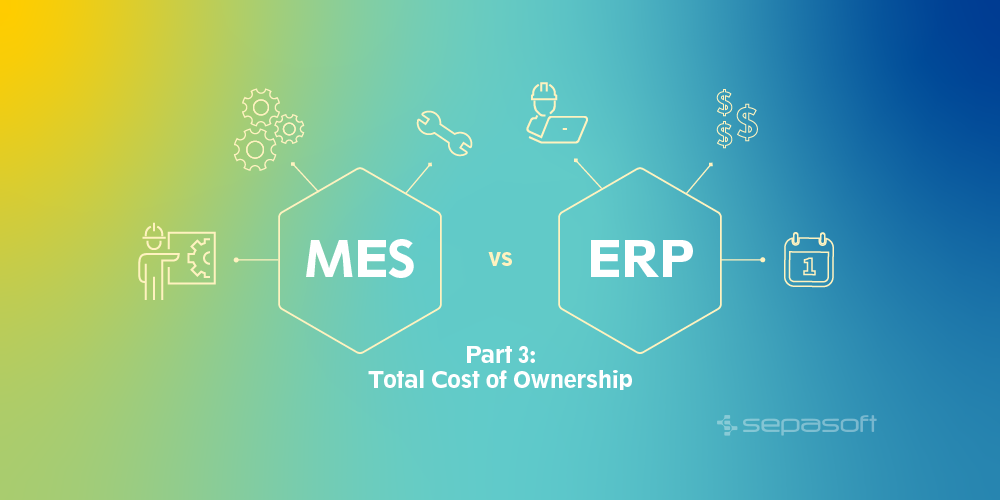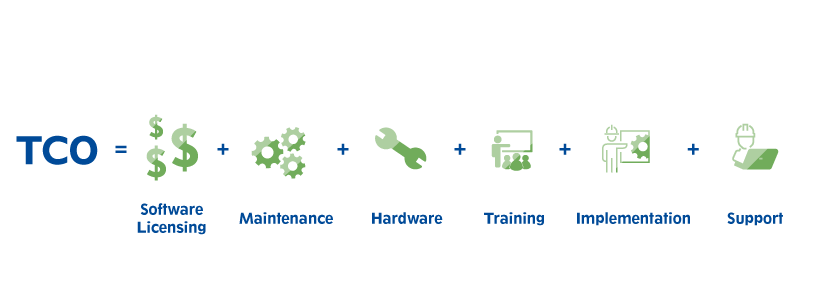MES VS. ERP | Part 3

TOP 3 ERP VS. MES DIFFERENCES | PART 3
Enterprise Resource Planning (ERP) vendors often advertise features provided by Manufacturing Execution Systems (MES), so we must ask, which system is best suited to the task? What is best for my organization?
Before we determine a solution path, we should consider the differences between ERP and MES and weigh their strengths and weaknesses. These considerations are classified under three categories: Time Scale, Context, and Cost. In this post, we will discuss the importance of considering the long-term Total Cost of Ownership (TCO) when comparing MES with ERP systems.
- Time Scale
- Context
- Total Cost of Ownership (TCO)
Part 3: Total Cost of Ownership (TCO)
Software can be expensive – especially ERP software. The total cost of ownership (TCO) is defined as the accumulation of both direct and indirect costs necessary to purchase, implement, and maintain software. Costs often neglected include support renewals, hardware, training, consulting, and more. When fielding a solution for your manufacturing IT project, consider not only the initial purchase price, but any ongoing costs and labor required to maintain or expand the system.
Licensing Model – Licensing models vary by vendor and software type. Some companies charge by user, tag, or some other metric, which may get costly if the project scope expands . When researching, develop an understanding of the licensing model and consider its impact on future expansions.
Support – Support will continue to be a component of TCO as long as manufacturers rely on customer support for critical assistance in a production crisis. Support contract renewals are typically an annual recurring cost.
Hardware – Some platforms require specific hardware for software compatibility or plant floor connection. Another possible driver of hardware requirements is whether data will be collected automatically or manually. For example, if a plant is establishing an infrastructure to automatically collect data from the plant floor for the first time, additional investment will be required to communicate with those machine controllers.
Consulting & Implementation – Implementation costs can vary greatly depending on the scope and experience of the implementation team. MES and ERP, in particular, have lengthier, more complex implementations. This labor cost will be a significant part of the budget.
Training – A project will only be successful if the new software is used properly. For example, operators need to be prepared to quickly handle the various production issues that may arise. Your budget should include the cost of training employees to prepare them to operate your new software.
Maintenance – Although commonly overlooked, hardware and software maintenance are not free. In addition to updates, upgrades, and other predictable maintenance, companies are constantly changing and evolving. New products are added, machines are changed or moved, and new initiatives are implemented. Assume these business changes will occur and factor them into your budget from the start.
Now that you’re familiar with the most significant elements of TCO, channel that knowledge into practice by utilizing the MES vs. ERP pricing comparison table below. This table is intended to promote consideration of each element for at least 5 years to reduce mid-implementation surprises.
| Cost Type | MES Y1 | ERP Y1 | … | MES Y5 | ERP Y5 |
| Licensing | |||||
| Support | |||||
| Hardware | |||||
| Consulting & Implementation | |||||
| Training | |||||
| Maintenance |
How Can Sepasoft Help You?
To learn what Sepasoft MES can do for your organization, please schedule a demo.
